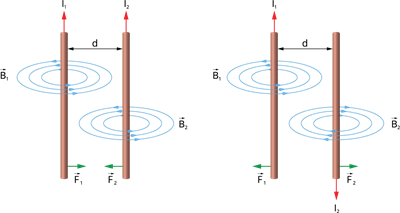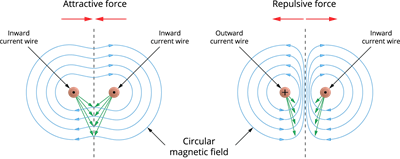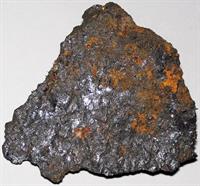PDF chapter test TRY NOW
A magnetic field surrounds a current-carrying conductor, as we have seen. If we place another current-carrying conductor parallel to the first, the magnetic field of the first conductor will exert a force on the second conductor. Similarly, the magnetic field of the second conductor will exert a force on the first conductor. The magnitude of these two forces will be equal but in the opposite direction.

Attractive and repulsive force on a current-carrying conductor
Using Fleming's left-hand rule, we can determine that when the current in both wires flows in the same direction, the force on the wires will be attracted to each other, i.e., the wires will experience an attractive force. The force on each wire, on the other hand, will be in the opposite direction if the flow of current is in the opposite direction.

Circular magnetic field
The above diagram shows the attractive and repulsive force between the current-carrying conductors when viewed perpendicular to the current direction.
Electricity and Magnetism:
Do you know the connection between the electricity and magnetism?
Magnetism and electricity were thought to be separate subjects of study prior to the \(18\)th century. Following Oersted's experiment, electricity and magnetism were combined into a single subject known as "Electromagnetism".
The magnetic field is created when there is current in the conductor, and the current-carrying conductor behaves like a magnet. You might be wondering how a lodestone could act like a magnet when there is no current flowing through it. It is only in the twentieth century, we realise that the magnetic property was caused by electron motion in the lodestone.

Lodestone
Electrons flow from the battery's negative end to the positive end of the circuit forming electric current. As a result, a magnetic field is created. The electrons moving around the nucleus in natural magnets and artificial magnets form the current, giving them magnetic property. Every orbiting electron acts as a current-carrying loop in this system. Even though electrons orbit the nucleus in all materials, the motion of electrons around the nucleus is only added up in particular types of material called Magnetic materials. As a result, we have a permanent magnetic field.
Reference:
https://commons.wikimedia.org/wiki/File:Lodestone_(Hot_Spring_County,_Arkansas,_USA)_1.jpg
